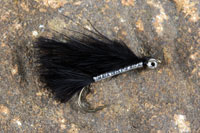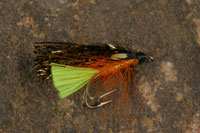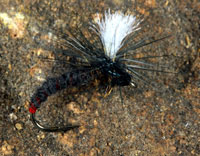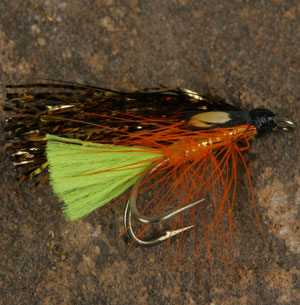 |
Black & Silver
Hook: Long-shank, size 10
Thread: Black
Tail and wing: Black marabou
Body: Flat silver tinsel
Rib: Silver wire
Eyes: Small chain beads
When I was asked for my most successful three flies, this pattern was at the top of the list. It’s a very simple creation, originally developed for the mighty ‘Loch Leven’. This fly has been responsible for some of my best baskets of fish from the place.
Like most fish-catching patterns, it travels really well and has given me some memorable catches from all over the UK.
The black-and-silver combination seems to prove irresistible to both brown and rainbow trout.
This fly was the template for its more famous or infamous cousin, The Humungus, designed by my late friend Jock Hodge. Need I say more?
 |
Freckle Flash Dunkeld
Hook: Kamasan B270, size 12
Thread: Black
Tail: Globrite floss No11
Body: Flat gold tinsel
Hackle: Hot orange cock
Rib: Gold wire
Wing: Gold Freckle Flash
Eyes: Jungle cock
This cracking little pattern took the competition scene by storm a number of years back and has been performing well ever since. It was also responsible for securing me a number of Scottish caps. It’s an out-and-out fish catcher from Loch Leven to Rutland and was a closely guarded secret for a while by competition anglers that fished Leven as their qualifier for the National Championship. The fly has also proved to be the top pattern for my successful competition team, The Leven Fly Casters.
It was originally designed for sunk-line work and it still performs best on fast-sinking lines. However, there are occasions when the fly scores well when used with an intermediate line.
 |
Dark Iron Blue Emerger
Hook: Kamasan B100, size 14 or 16
Thread: Black
Tag and rib: Crimson/red tying thread
Body: Natural mole fur
Thorax: Dark hare’s ear
Post: White Glo-Brite yarn
Hackle: Dark iron blue cock
Contrary to popular belief, I began fishing on rivers way before I started on the stillwater scene. Having a father that was passionate about dry-fly fishing, I was introduced to the art at a very early age.
This pattern is one that I use to imitate the naturals that appear on the Tay in spring. Its dark, inky-blue features bear no resemblance to the abundant supply of olives that are normally present at this time of year.
Many an angler has been fooled by this little fly, the reason being that it seems to be picked out by the trout, even though there are flotillas of olives coming down the river.
This fly is a great ‘prospecting pattern’, which can be used throughout the season to bring trout up – this is why it’s one of my favourites.






